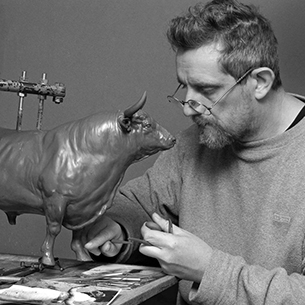Biography
Born in County Durham in 1960, Bibby started drawing and painting as soon as he could hold a pen (or paintbrush). His earliest sculptures as a toddler, were made from plasticine, or on some occasions, Opal Fruits (chewy fruit sweets) when the plasticine ran out, and he sold his first sculpture at age thirteen, becoming a full-time sculptor in his late teens.Largely self taught; Nick Bibby has always had an abiding love of nature and the natural world and this, in combination with his interests in anatomy, zoology and palaeontology, are what drive his work. Using copious reference, either from life or literature, he first constructs a supporting armature of steel and aluminium that often closely matches the skeleton of his subject. He does not usually make working drawings. Having researched his subject, Bibby builds up a fluid mental image of the finished sculpture; a three dimensional image that does not benefit from being translated into two dimensional drawings, only to be translated back into 3 dimensions in the finished sculpture. As clay or wax is added to the supporting armature, building up the sculpture, he makes constant minor adjustments to composition, pose and form, always striving for the perfect aesthetic balance. The variety of the ever expanding ‘Bibby’ sculpture collection; birds, animals, and human, is driven by Nick’s constant search for knowledge and new challenges.
Nick exhibits work regularly at Sladmore Contemporary, Mayfair, London, as well as several other galleries in the UK. In addition, his work has been shown at The Royal Academy of Art, London, the Pinacoteca Giovanni e Marella Agnelli, Turin, Leigh Yawkey Woodson Museum of Art, Wisconsin, Sigurjon Olafsson Museum, Reykjavik and the Society of Portrait Sculptors, London, to name but a few.In 1999 Nick Bibby was asked to sculpt life-size, scientifically accurate, bronzes of a dozen extinct birds and animals from the islands of Mauritius, Rodrigues and Réunion, including the most famous extinction of all – the Dodo. One of Nick’s most enjoyable commissions, “Bones to Bronze” was sculpted in close partnership with naturalists and palaeontologists from the region. The sculptures were created to raise awareness of the species lost and the species we continue to lose, whilst also raising funds toward continued conservation work on the islands through their sale. A complete collection is on permanent exhibition on the island of Ile aux Aigrettes, just off the coast of Mauritius, and a ‘Bibby’ Dodo is on permanent exhibition at the Ashmolean Museum, in Oxford. This Dodo has even had a children’s book written about him!

